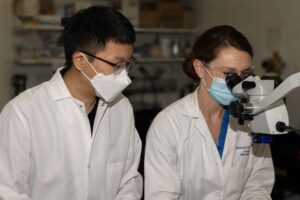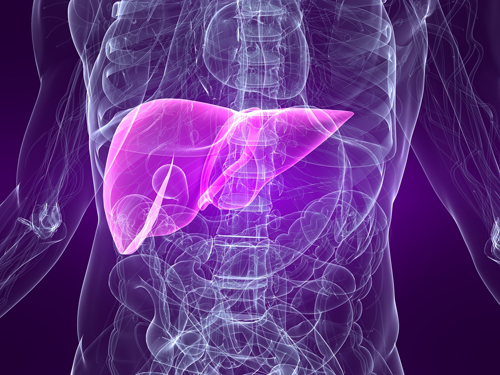Research by scientists at Washington University School of Medicine in St. Louis suggests that a type of high-density lipoprotein (HDL) that is produced by the intestine plays a previously unknown role in protecting the liver from injury. The team’s studies showed that this type of HDL, known as HDL3, protects the liver by blocking inflammatory signals produced by common gut bacteria. Experiments in mice demonstrated that HDL3 from the intestine bound to bacterially derived lipopolysaccharide (LPS), which prevented activation of inflammatory macrophages in the liver.
“Even though HDL has been considered ‘good cholesterol,’ drugs that increase overall HDL levels have fallen out of favor in recent years because of clinical trials that showed no benefit in cardiovascular disease,” said Gwendalyn J. Randolph, PhD, the Emil R. Unanue distinguished professor of immunology. “But our study suggests that raising levels of this specific type of HDL, and specifically raising it in the intestine, may hold promise for protecting against liver disease, which, like heart disease, also is a major chronic health problem.” Randolph is senior author of the team’s published report in Science, which is titled, “Enterically derived high-density lipoprotein restrains liver injury via the portal vein.”
HDL cholesterol (HDL-C) is mostly known for mopping up cholesterol in the body and delivering it to the liver for disposal. But HDL may also have anti-inflammatory or antimicrobial activity, through its interaction with different plasma proteins, the authors explained. And while most HDL is produced by the liver, some is also produced by the intestine. “However, a role for intestinal HDL distinct from that produced by the liver has not been identified,” the authors noted. “Indeed, it is unclear why HDL is synthesized by the intestine rather than solely by the liver.”
Any sort of intestinal damage can impact how Gram-negative bacteria affect the body. These bacteria produce the inflammatory molecule lipopolysaccharide, which can travel to the liver via the portal vein. The portal vein is the major vessel that supplies blood to the liver, and it carries most nutrients to the liver after food is absorbed in the intestine. Substances from gut microbes may travel along with nutrients from food to activate immune cells that trigger inflammation. In this way, elements of the gut microbiome may drive liver disease, including fatty liver disease and liver fibrosis, in which the liver develops scar tissue.
One of the obstacles to considering a potential role for intestinal HDL in what the team term as the gut-liver axis, is the relative lack of knowledge concerning how enterically derived HDL is actually delivered to the liver. “HDL typically mobilizes from tissues through lymphatic vessels, which do not route to the liver from the intestine,” they pointed out.
In their new study, the researchers found that intestinally produced HDL3 travels via the portal vein to the liver, rather than via the lymphatic system from the intestine, and this finding hinted at the possibility that HDL3 may have a liver protective capability. “… intestinal HDL rapidly entered the portal vein, the major blood supply to the liver,” they wrote. “This finding raised the issue of whether the liver might benefit from intestinal HDL and pointed us to an older concept that HDL might neutralize a key microbial signal that can escape a permeable gut: LPS from Gram-negative bacteria.”
The newly reported studies have now shown that this intestinally-produced HDL3 does protect the liver from inflammation in mice, by blocking bacterially derived LPS. Randolph became interested in the topic through a collaboration with two Washington University surgeons, Emily J. Onufer, MD, a surgical resident, and Brad W. Warner, MD, the Jessie L. Ternberg PhD, MD, distinguished professor of pediatric surgery and chief surgeon at St. Louis Children’s Hospital. Both Onufer and Warner are co-authors of the study.
Some premature infants develop a life-threatening condition called necrotizing enterocolitis, an inflammation of the intestine that can require a portion of the intestine to be surgically removed. Even after successful bowel surgery, affected babies may often develop liver disease, and Onufer and Warner wanted to understand why.
“They were studying this problem in a mouse model of the condition: They remove a portion of the small intestine in mice and study the liver fibrosis that results,” Randolph explained. “There were hints in the literature that HDL might interfere with lipopolysaccharide’s detection by immune cells and that the receptor for lipopolysaccharide might be linked to liver disease following the bowel surgery.

As the HDL3 makes this short journey down the portal vein, it binds to a protein called lipopolysaccharide binding protein—LBP—which binds to the harmful lipopolysaccharide. Harmful lipopolysaccharide bound to this complex is then blocked from activating immune cells called Kupffer cells (KCs). These are macrophages that reside in the liver and, when activated by lipopolysaccharide, can drive liver inflammation. So, as a complex of proteins and fats, HDL3 uses its partnership with LBP to bind to LPS. When LBP is part of the HDL3 complex, it prevents the harmful bacterial molecule from activating the liver Kupffer cells and inducing inflammation, according to experiments conducted by first author Yong-Hyun Han, PhD, a postdoctoral researcher in Randolph’s lab, who is now on the faculty of Kangwon National University in South Korea.
“We think that LBP, only when bound to HDL3, is physically standing in the way, so lipopolysaccharide can’t activate the inflammatory immune cells,” Han said. “HDL3 is essentially hiding the harmful molecule. However, if LBP is binding to lipopolysaccharide and HDL3 is not present, LBP is not able to stand in the way. Without HDL3, LBP is going to trigger stronger inflammation.” The authors further summarized, “We show here that the intestine produces the small form of HDL called HDL3 and that it is enriched in LBP. This HDL is shuttled to the liver through the portal vein. By the time it reaches the portal blood, it is already complexed with LBP, and the LPS that it carries is masked so that it does not bind to liver KCs, circumventing the induction of proinflammatory and profibrotic genes. The intestinal epithelial location for HDL production allows the local capture of LPS before it gains access to downstream tissue.”
The researchers in addition showed that liver injury is worse when HDL3 from the intestine is reduced, for example, as a result of surgical removal of a portion of the intestine. “The surgery seems to cause two problems,” Randolph said. “A shorter intestine means it’s making less HDL3, and the surgery itself leads to an injurious state in the gut, which allows more lipopolysaccharide to spill over into the portal blood. When you remove the part of the intestine that makes the most HDL3, you get the worst liver outcome. When you have a mouse that cannot genetically make HDL3, liver inflammation is also worse. We also wanted to see if this dynamic was present in other forms of intestinal injury, so we looked at mouse models of a high-fat diet and alcoholic liver disease.”
In all of these models of intestinal injury, the researchers found that HDL3 was protective, binding to the additional lipopolysaccharide released from the injured intestine and blocking its downstream inflammatory effects in the liver. “… HDL3 produced by the intestine protected the liver from the inflammation and fibrosis observed in a variety of mouse models of liver injury that parallel clinically relevant conditions in humans, including surgical resection of the small bowel, alcohol consumption, or high-fat diets,” the scientists stated. They further showed that the same protective molecular complexes were present in human blood samples, suggesting a similar mechanism is present in people.
Interestingly, in further experiments, the team also used a drug compound to increase HDL3 in the intestines of mice and found that this was similarly protective against different types of liver injury. “Administration of an oral drug targeting the transcription factor liver X receptor, the master regulator of genes associated with HDL biogenesis, raised enteric HDL levels and protected the mice from liver pathology,” the authors explained. “This protection was lost if mice did not express enterically derived HDL, indicating that intestinal HDL was a key target of the drug.”
While the drug compound is only used for animal research, the study revealed new possibilities for treating or preventing liver disease, whether it stems from damage to the intestine caused by high-fat diets, alcohol overuse, or physical injury, such as from surgery. The authors further concluded, “Enteric HDL may thus be a suitable pharmacologic target for protecting the liver against gut-derived LPS leakage in alcoholic and nonalcoholic settings.”
“We are hopeful that HDL3 can serve as a target in future therapies for liver disease,” Randolph said. “We are continuing our research to better understand the details of this unique process.”



